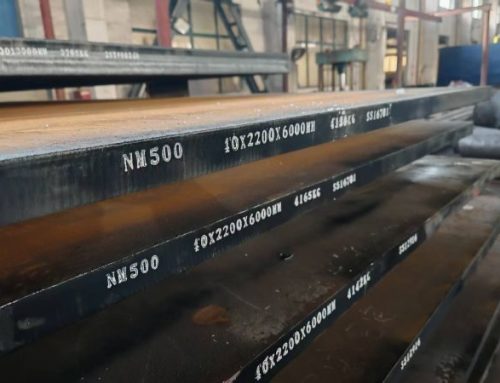As a benchmark for high-end wear-resistant steel in China, “NM” in NM450 stands for the first letter of the Chinese pinyin for “wear-resistant,” and “450” represents the average Brinell hardness value.
As an “all-rounder” among low-alloy high-strength wear-resistant steels, NM450 steel achieves extremely high strength, hardness, and excellent toughness through a quenching and tempering heat treatment process, making it an ideal material for mining and construction machinery.It can extend equipment life by 3-5 times while significantly reducing maintenance costs, making it a reliable choice for modern industry to cope with high-wear conditions.

NM450 STEEL CHEMICAL COMPOSITION
| Grade | C | Si | Mn | P | S | Cr | Mo | Ni | Ti | B | Als |
| NM450 | ≤0.35 | ≤0.7 | ≤1.7 | ≤0.025 | ≤0.01 | ≤1.4 | ≤0.55 | ≤0.8 | ≤0.05 | 0.0005-0.006 | ≥0.01 |
NM450 STEEL RELATED STANDARD & EQUIVALENT GRADE
| Germany | Sweden | Japan |
| DILLIDUR 450V | SSAB HARDOX 450 | JFE-EH450 |
NM450 Steel Physical Properties
- Density: 7.85 g/cm³ (same as ordinary steel plate)
- Elastic modulus: 206 GPa (20℃)
- Thermal conductivity: 45 W/(m・K) (20℃)
- Coefficient of linear expansion: 11.5×10⁻⁶/℃ (20-600℃)
- Temperature resistance range: -40℃ to 550℃ (performance decreases significantly outside this range)
NM450 Steel Mechanical Properties
| Grade | Thickness(mm) | Surface Hardness(HBW) | Center Hardness(HBW) | Tensile Strength,Mpa | Elongation,% | Longitudinal impact,J |
| NM450 | ≤80 | 420-480 | 375-480 | ≥1250 | ≥8 | ≥24 |
| >80-120 | 410-480 | - | ≥21 |
QUICK FAQS FOR NM450 STEEL
Why does NM450 steel have high wear resistance?
Principle: Through quenching and tempering heat treatment, a martensitic + bainitic composite structure is formed, with dispersed carbides (Cr₂₃C₆, Mo₂C) distributed on the NM450 steel matrix.
Performance: NM450 is 2.5-3 times more wear-resistant than Q345 ordinary steel plate and 15-20% more wear-resistant than NM400. Its service life is increased by 3-5 times under ore friction and material impact scenarios.
Can NM450 steel be welded?
Although NM450 is a high-hardness steel, reliable welding can be achieved through proper processes. The key is “temperature control + low hydrogen“.
Why does the hardness of NM450 steel decrease after welding?
If the heat-affected zone of the weld is overheated, the martensitic structure will transform into pearlite, reducing the hardness by 10-20%.
Solution: Perform low-temperature tempering at 200-250℃ after welding, or control the welding heat input (reduce current, increase speed).
What is the cutting process for NM450 steel?
NM450 steel supports laser, plasma, and flame cutting, with laser cutting yielding the best results: minimal heat-affected zone (≤3mm) and smooth cut surface.
Why does NM450 steel crack after cold working?
Due to the high hardness of NM450 steel, if the cold bending radius is too small or the stamping deformation is too large after cold working, the internal stress will be high, which can easily lead to cracking.
Solution: Increase the bending radius (≥3 times the plate thickness), and perform stress-relieving tempering at 150-200℃ immediately after cold working.
Is NM450 steel corrosion resistant?
NM450 steel has superior corrosion resistance compared to ordinary carbon steel, and its surface easily forms an oxide film, which can resist mild acid and alkali environments.
For use in highly corrosive environments, surface treatments such as painting or hot-dip galvanizing can be used for reinforcement.
NM450 Steel Application
Applications where NM450 is preferred: medium to high wear + moderate impact (such as crusher liners, excavator bucket teeth), and where lightweight components are required (high strength can reduce thickness).
Typical application scenarios (with specific components)
1. Mining Machinery (40%)
- Crushers: Liners, jaw plates, eccentric bushings (resisting ore crushing and abrasion)
- Conveying Equipment: Chutes, buckets, conveyor belt idlers (withstanding material impact and friction)
- Screening Equipment: Vibrating screen plates, screen frames (wear-resistant and vibration-impact resistant)
2. Construction Machinery (30%)
- Excavators: Bucket teeth, bucket side plates, bucket bottom (high-intensity wear from excavating rock and concrete)
- Loaders: Bucket, bucket tooth holders, connecting rods (continuous friction from loading and unloading ore and slag)
- Bulldozers: Blades, track plates (wear-resistant and impact-resistant under harsh working conditions)
3. Metallurgy and Building Materials (15%)
- Cement Plants: Mill liners, classifier blades, cyclone separator liners (cement clinker wear)
- Metallurgical Plants: Blast furnace hoppers, sintering machine trolley panels, chutes (high temperature + Material Wear)
- Concrete Machinery: Mixer truck blades, mixing arms, pump truck delivery pipes (concrete friction)
4. Other Fields (15%)
- Environmental Protection Equipment: Waste incinerator linings, waste compactor heads (waste corrosion + wear)
- Port Machinery: Grab bucket teeth, dock conveyor chutes (bulk cargo handling wear)
- Vehicle Industry: Dump truck floor plates, mining truck bodies (ore transportation wear)
NM450 STEEL SUPPLY FORM & SIZE
- NM450 Wear Resistant Plate: thickness 3mm ~ 100mm x 1250~3300mm width x L
- Surface Condition: Black surface
- Heat Treatment: Q+T (Pre-hardening)
